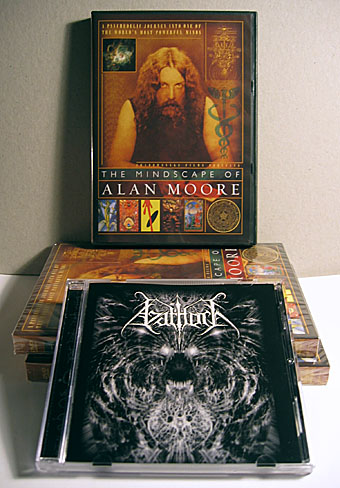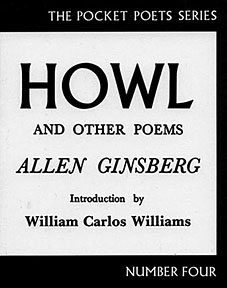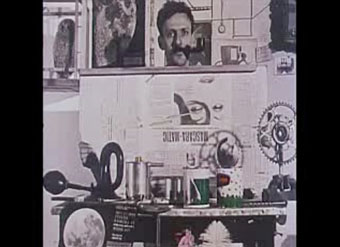No-go logos: The story of unpopular branding
The 2012 Olympics logo gets another kicking.
Short films by Walerian Borowczyk
Les Astronautes (1959).
A nice collection of shorts by Walerian Borowczyk (1923–2006) at Ubuweb including this animated piece from 1959 which was co-directed by Chris Marker. The style is immediately reminiscent of that employed by Raoul Servais in Harpya and other films; it’s also not far removed from Terry Gilliam’s animation but it predates both. Also of note is Une Collection Particulière from 1973, a brief but fascinating look at a collection of antique pornographic toys and other adult items from the collection of Pieyre De Mandiargues. And L’Amour Monstre de tous les Temps from 1977 is a portrait of contemporary erotic Surrealist painter Ljuba Popovic at work. Borowczyk spent the Seventies making soft porn features such as Immoral Tales and The Beast, so the subject matter of the later films isn’t so surprising.
Previously on { feuilleton }
• Taxandria, or Raoul Servais meets Paul Delvaux
• Monsieur Chat
• The Brothers Quay on DVD
• Sans Soleil
• Barta’s Golem
• The art of Ljuba Popovic
New things for June

New and not-so-new work-related arrivals include The Mindscape of Alan Moore DVD which finally arrived after the usual postal delays caused by bank holidays and other trivia. Those interested can order this from the Shadowsnake Films site.
And copies of the CD from metal band Azathoth turned up a few weeks ago but I’d neglected to mention this. My sole involvement was letting them use my Azathoth portrait from The Haunter of the Dark for the cover but they’ve done a nice job with the rest of the design. Their insectile name/logo fits very well with the picture.
Alternative London Olympics logos
Alternative London Olympics logos
Good, bad and ugly.
Ginsberg’s Howl and the view from the street
 James Campbell in The Guardian this weekend writes about the arrest fifty years ago of Lawrence Ferlinghetti for his publishing Allen Ginsberg’s paean to ecstatic drug use and gay sex, Howl and Other Poems. Ferlinghetti was arrested on charges of selling (or “peddling”, as these prissy turns of phrase always have it) literature likely to be harmful to minors, even though it’s hard to imagine there were gangs of schoolkids rushing into his City Lights bookstore to buy a volume of experimental poetry. The ensuing trial was the first in a series of cases in the late Fifties and early Sixties which finally established (in America, at least) that the law needed to try and keep its hands off literary works.
James Campbell in The Guardian this weekend writes about the arrest fifty years ago of Lawrence Ferlinghetti for his publishing Allen Ginsberg’s paean to ecstatic drug use and gay sex, Howl and Other Poems. Ferlinghetti was arrested on charges of selling (or “peddling”, as these prissy turns of phrase always have it) literature likely to be harmful to minors, even though it’s hard to imagine there were gangs of schoolkids rushing into his City Lights bookstore to buy a volume of experimental poetry. The ensuing trial was the first in a series of cases in the late Fifties and early Sixties which finally established (in America, at least) that the law needed to try and keep its hands off literary works.
America since 1957 has managed to grow up on one level, with Howl now regarded as a classic work of 20th century poetry, and grow more infantile on the other, with And Tango Makes Three, a childrens’ book about gay penguins, being the most-challenged book of 2006 according to the America Library Association; you can still rely on the “g” word to get the would-be book-burners agitated. The growing gulf between perceptions of morality in the US versus those in Europe can be seen in the way that US librarians need to hold an annual Banned Books Week to draw attention to the ongoing war between prudery and licence while there’s no equivalent to this in the UK. Britons used to look enviously at America’s freedoms of speech but the atmosphere has relaxed considerably here over the past twenty years while in America it sometimes seems that the clock is running backwards. That said, Russ Kick pointed out several years ago how, even among freedom-loving librarians, some books are more defensible than others.
The City Lights bookstore is located at 261 Columbus Avenue, San Francisco, and by coincidence I’ve spent the past couple of days exploring that locale using Google’s remarkable Street View facility which is now a feature on their San Francisco map, together with those for New York, Miami, Las Vegas and Denver. Not all the streets in these cities have been photographed yet but it’s fascinating to not only see places you’ve already been to but then turn down a side street and see the places you missed. If you want to know what it’s like to drive across the Golden Gate Bridge then here’s your chance.
Continue reading “Ginsberg’s Howl and the view from the street”


